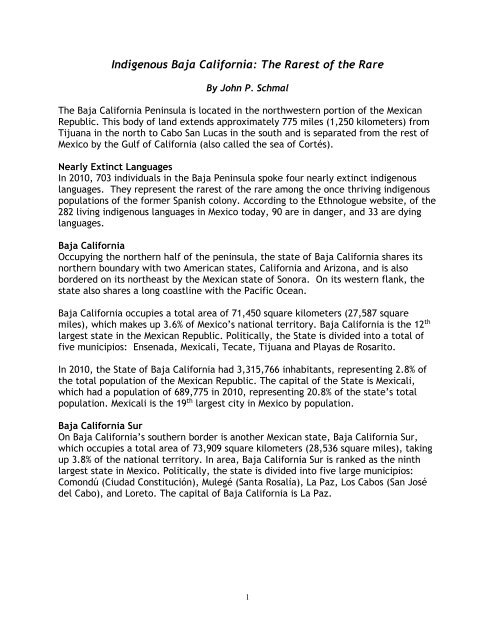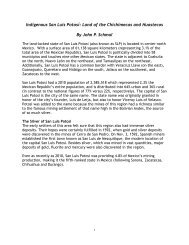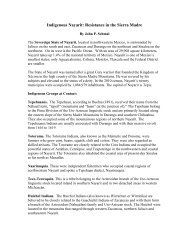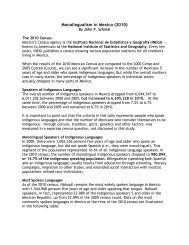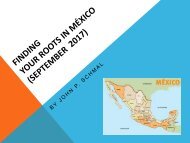Baja Indigenous History Final
Create successful ePaper yourself
Turn your PDF publications into a flip-book with our unique Google optimized e-Paper software.
<strong>Indigenous</strong> <strong>Baja</strong> California: The Rarest of the Rare<br />
By John P. Schmal<br />
The <strong>Baja</strong> California Peninsula is located in the northwestern portion of the Mexican<br />
Republic. This body of land extends approximately 775 miles (1,250 kilometers) from<br />
Tijuana in the north to Cabo San Lucas in the south and is separated from the rest of<br />
Mexico by the Gulf of California (also called the sea of Cortés).<br />
Nearly Extinct Languages<br />
In 2010, 703 individuals in the <strong>Baja</strong> Peninsula spoke four nearly extinct indigenous<br />
languages. They represent the rarest of the rare among the once thriving indigenous<br />
populations of the former Spanish colony. According to the Ethnologue website, of the<br />
282 living indigenous languages in Mexico today, 90 are in danger, and 33 are dying<br />
languages.<br />
<strong>Baja</strong> California<br />
Occupying the northern half of the peninsula, the state of <strong>Baja</strong> California shares its<br />
northern boundary with two American states, California and Arizona, and is also<br />
bordered on its northeast by the Mexican state of Sonora. On its western flank, the<br />
state also shares a long coastline with the Pacific Ocean.<br />
<strong>Baja</strong> California occupies a total area of 71,450 square kilometers (27,587 square<br />
miles), which makes up 3.6% of Mexico’s national territory. <strong>Baja</strong> California is the 12 th<br />
largest state in the Mexican Republic. Politically, the State is divided into a total of<br />
five municipios: Ensenada, Mexicali, Tecate, Tijuana and Playas de Rosarito.<br />
In 2010, the State of <strong>Baja</strong> California had 3,315,766 inhabitants, representing 2.8% of<br />
the total population of the Mexican Republic. The capital of the State is Mexicali,<br />
which had a population of 689,775 in 2010, representing 20.8% of the state’s total<br />
population. Mexicali is the 19 th largest city in Mexico by population.<br />
<strong>Baja</strong> California Sur<br />
On <strong>Baja</strong> California’s southern border is another Mexican state, <strong>Baja</strong> California Sur,<br />
which occupies a total area of 73,909 square kilometers (28,536 square miles), taking<br />
up 3.8% of the national territory. In area, <strong>Baja</strong> California Sur is ranked as the ninth<br />
largest state in Mexico. Politically, the state is divided into five large municipios:<br />
Comondú (Ciudad Constitución), Mulegé (Santa Rosalía), La Paz, Los Cabos (San José<br />
del Cabo), and Loreto. The capital of <strong>Baja</strong> California is La Paz.<br />
1
In 2010, <strong>Baja</strong> California Sur had 712,029 inhabitants, which represented 0.6% of the<br />
total Mexican population. Only one state ‒ Colima ‒ has a smaller population. In 2010,<br />
the capital city of La Paz had a population of 215,178, which represented over 30% of<br />
its total state population.<br />
The Sad Legacy of the <strong>Baja</strong> Indians<br />
The story of the indigenous peoples of the <strong>Baja</strong> Peninsula is a sad one. Living in an<br />
arid environment, their susceptibility to the ravages of war and disease was<br />
accentuated by their already marginal existence. The vast majority of the <strong>Baja</strong><br />
Indians have disappeared and those that have survived in the north are represented<br />
by as few as a dozen individuals or as many as a few hundred. Ironically, most of the<br />
Mexican indigenous languages spoken in the two <strong>Baja</strong>s are actually tongues brought to<br />
the Peninsula by migrant workers from other states, in particular Oaxaca.<br />
Early Contacts between Spaniards and <strong>Indigenous</strong> Inhabitants<br />
In 1532 – a decade after the destruction of the Aztec Empire – the Spanish conqueror<br />
Hernán Cortés sent an expedition commanded by his cousin, Diego Hurtado de<br />
Mendoza, to explore the <strong>Baja</strong> California Peninsula and other locations along the<br />
Pacific coastline of northwest México. A second expedition to the area left Santiago,<br />
Colima, on October 29, 1533. The voyage was a disastrous failure, but mutineers from<br />
this expedition explored the area now called La Paz.<br />
In April 1535, Cortés himself led a third expedition of three ships that landed near<br />
present-day La Paz on May 3, 1535, where he formally took possession of the land for<br />
the King of Spain. Cortés founded a small colony in the area, but the local Indians<br />
remained very hostile towards the visitors. By November 1535, more than 70 of<br />
Cortés’ men had died from starvation or skirmishes with the indigenous population.<br />
Early in 1536, Cortés posted 30 Spaniards to man the small colony and sailed back for<br />
Mexico. A fourth expedition led by Francisco de Ulloa in June 1539 found that the<br />
small colony had been destroyed. Other expeditions followed, but they frequently<br />
encountered large groups of natives who strongly resisted their intrusions. For this<br />
reason, the colonization and settlement of the <strong>Baja</strong> Peninsula was a very slow<br />
process, complicated by the hostility of the indigenous groups and the great distance<br />
from sources of supply, as well as by inhospitable weather conditions.<br />
<strong>Indigenous</strong> Groups at Contact<br />
At the time of contact, <strong>Baja</strong> California Norte was primarily inhabited by several<br />
indigenous groups belonging to the Yuman language branch of the Hokan linguistic<br />
family. Most of these early inhabitants lived by hunting and fishing, but some of them<br />
also gathered acorns, seeds, prickly pears, apples, pine nuts and other small edible<br />
plants found in the harsh desert environment.<br />
2
The northernmost aboriginal <strong>Baja</strong> Californians spoke several closely-related Yuman<br />
languages, most notably the Kiliwa, Paipai, Kumeyaay (Kumiai), and Cocopá (Cucapá)<br />
tongues. Using the controversial technique of glottochronology, it has been estimated<br />
that the initial separation of the Yuman family into different languages occurred<br />
perhaps 2,500 years ago. The Cocopá and Kumiai languages are believed to be very<br />
closely related to each other, separated by perhaps about one thousand years of<br />
independent development. The historical location of the indigenous <strong>Baja</strong> tribal groups<br />
at the time of the Spanish contact can be seen at the following Wikipedia link:<br />
https://es.wikipedia.org/wiki/Cochimí<br />
Paipai<br />
The Paipai Indians – also known as Akwa'ala – occupied the northern Sierras in the<br />
interior of the northern <strong>Baja</strong> California Peninsula. Their original territory included<br />
the lower Colorado River Valley in the present day municipios of Ensenada and<br />
Mexicali, as well as adjacent areas in western Arizona, southern California, and<br />
northwestern Sonora.<br />
Kumeyaay (Kumiai)<br />
The Kumiai (Kumeyaay) Indians were hunters, gatherers and fishers who inhabited<br />
coastal, inland valley, and mountain regions along the present-day <strong>Baja</strong> California<br />
border region with the United States. The traditional Kumeyaay territory originally<br />
extended from around Escondido in California to the northern part of the present day<br />
municipio of Ensenada. Occupying the southern section of present-day San Diego<br />
County in California, the Kumeyaay inhabited the region near the San Diego Presidio<br />
when it was founded in 1769. The Kumeyaay in the vicinity of San Diego were also<br />
referred to as the Diegueño by the Spaniards.<br />
Cochimí<br />
The Cochimí Indians inhabited a considerable part of the central <strong>Baja</strong> Peninsula, from<br />
north of Rosario to the vicinity of Loreto in east central <strong>Baja</strong> California. Like many of<br />
the other <strong>Baja</strong> tribes, the Cochimí Indians survived by fishing in the coastal areas and<br />
gathering fruits and seeds for sustenance in other areas.<br />
Cucapás (Cocopá)<br />
The Cucapás, living in the desert region along the Colorado River in the frontier zone<br />
of <strong>Baja</strong> California Norte and Sonora, fished and hunted deer, rabbit, moles, mountain<br />
lion and coyote. They also collected a wide variety of desert products, including<br />
cactus flowers, potatoes, and wild wheat.<br />
3
Kiliwa<br />
The Kiliwa Indians were hunters who inhabited northeastern <strong>Baja</strong> California. The<br />
Kiliwa lived along the eastern slope of the Sierra San Pedro Mártir and ranged down<br />
the Gulf Coast. Their habitat also extended into the Colorado Desert.<br />
Guaycura (Guaicura or Waicuri)<br />
The Guaycuras lived in the middle part of the lower <strong>Baja</strong> peninsula, inhabiting the<br />
Magdalena Plains from Loreto down to and including the La Paz area.<br />
Pericú<br />
The Pericú occupied the southern tip of the peninsula around San José del Cabo and<br />
several large Gulf islands, including Cerralvo, Espíritu Santo, San José, and Santa<br />
Catalina.<br />
The Colonization of <strong>Baja</strong> California Sur<br />
In 1596, King Felipe II of Spain ordered the colonization of the <strong>Baja</strong> California<br />
Peninsula. Six years later, Sebastián Vizcaíno made his famous voyage to <strong>Baja</strong>,<br />
exploring the present-day site of Cabo San Lucas, where he was confronted by a force<br />
of 800 native warriors. Vizcaíno managed to build a fort at La Paz, but after a<br />
skirmish with local natives, the post had to be abandoned by the Spaniards.<br />
In 1683, Admiral Isidro Atondo y Antillón led a state-sponsored expedition to <strong>Baja</strong> and<br />
established a settlement at La Paz. However, according to Mr. Laylander, the<br />
settlement “was abandoned after a few months because of escalating conflicts with<br />
the native inhabitants.” Another post was established at San Bruno, north of Loreto,<br />
but was also abandoned in 1685 “because of meager local resources and uncertain<br />
outside supplies.”<br />
The Jesuit Missionaries<br />
In October 1697, Jesuit missionaries started arriving in the southern <strong>Baja</strong> peninsula<br />
with the intention of establishing missions. On October 19, 1697, Father Juan María de<br />
Salvatierra established the first permanent mission in <strong>Baja</strong> California Sur, dedicating<br />
it with the name of Our Lady of Loreto de Concho, near present-day Loreto, <strong>Baja</strong><br />
California Sur. Between 1697 and 1767, Jesuit missionaries would establish sixteen<br />
missions throughout the length of the <strong>Baja</strong> Peninsula.<br />
The Jesuit missions played an integral role in the Christianizing of the indigenous<br />
peoples. However, to accomplish their objectives, the missionaries resettled and<br />
congregated many of their converts in rancherías that were located close to the<br />
missions. Although this practice was effective in enforcing religious instruction,<br />
tribute collection, and the organization of a work force, the concentration of the<br />
natives had a devastating effect on the aboriginal groups and made them more<br />
susceptible to smallpox, typhus, measles and other infectious diseases.<br />
4
Don Laylander, in “The Linguistic Prehistory of <strong>Baja</strong> California,” has written that “the<br />
linguistic map of <strong>Baja</strong> California underwent dramatic changes during the historic<br />
period, culminating in the extinction of many of its aboriginal languages. Before<br />
extinction, prehistoric lifeways were altered in a myriad of ways, through such factors<br />
as externally-introduced epidemic diseases, military conflicts, and the relocation of<br />
populations to mission settlements.” The most serious epidemic was the typhus<br />
epidemic of 1742-1744, which probably killed 8,000 Indians. During the following<br />
decades, entire tribes disappeared, while small bands of Pericú, Guaycura, and<br />
Cochimí – struggled to survive in the south.<br />
The Revolts of 1734-1744<br />
The most serious rebellion in the southern part of the <strong>Baja</strong> Peninsula took place in<br />
1734-1737. This uprising of the Pericú and Guaycuras engulfed several missions in the<br />
southern part of the peninsula, most of which had to be abandoned. In January 1735,<br />
indigenous forces ambushed the Manila Galleon that had stopped at San José del Cabo<br />
for supplies. “The revolt and its subsequent suppression,” according to Don Laylander,<br />
“hastened the disorganization and declines of the southern aboriginal groups. To<br />
suppress the revolt, the Jesuits were forced to call in outside military assistance.” In<br />
1742, King Felipe V authorized the use of royal funds to suppress the revolt. The<br />
arrival of a military force from Sinaloa helped to restore order and reestablish control<br />
of the southern <strong>Baja</strong> lands. The last scattered resistance to the Spaniards did not end<br />
until 1744.<br />
The Expulsion of the Jesuits<br />
In June 1767, King Carlos III of Spain expelled all the Jesuit missionaries from México.<br />
Eventually, the Dominicans continued the missionary efforts of the Jesuits, especially<br />
in the territories of the Cochimí, Kiliwa, Paipai, and Kumeyaay. However, by this<br />
time, southern <strong>Baja</strong>’s indigenous populations had declined to the point of no return.<br />
Don Laylander explains that “in the nineteenth and twentieth centuries, the role of<br />
aboriginal peoples in the peninsula’s history has become increasingly marginal. In the<br />
central and southern portions of the peninsula, culturally distinct aboriginal<br />
populations had disappeared before 1900.”<br />
The Kiliwa were one of the few <strong>Baja</strong> groups that was able to hang on, albeit<br />
precariously. In 1840, the Kiliwa, who lived in <strong>Baja</strong>’s northeast corner, successfully<br />
rebelled against the Dominicans and fled into quiet isolation. This seclusion enabled<br />
the Kiliwa to survive into the Twentieth Century. In 1938, University of California<br />
Berkeley anthropologist, Peveril Meigs, searched the entire <strong>Baja</strong> Peninsula for<br />
surviving bands. At that time, he located and did studies on a small band of about<br />
fifty Kiliwa living in the east-facing canyons of northern <strong>Baja</strong>’s mountains.<br />
5
Political Chronology<br />
In January 1824, after the Mexican Republic was constituted, the central government<br />
organized and oversaw the Territory of <strong>Baja</strong>. Twenty four years later, the Treaty of<br />
Guadalupe Hidalgo – which ended the Mexican-American War – divided the territory of<br />
California, with the northern half, called Alta California, being ceded to the United<br />
States, while the southern half remained with Mexico as <strong>Baja</strong> California.<br />
On April 26, 1850, two partidos (secondary administrative divisions) were created as<br />
<strong>Baja</strong> California Norte and <strong>Baja</strong> California Sur. On December 14, 1887, the status of<br />
both partidos was changed to distritos (districts), and on January 1, 1888, the<br />
northern part of the peninsula became known as the Northern District of <strong>Baja</strong><br />
California. On December 30, 1930, the separate territories of <strong>Baja</strong> California Norte<br />
and <strong>Baja</strong> California Sur were created, effective February 7, 1931. The northern<br />
territory became a state on January 16, 1952, while the southern <strong>Baja</strong> State achieved<br />
statehood on October 24, 1974.<br />
<strong>Indigenous</strong> Groups of the Twentieth Century<br />
By the end of the Nineteenth Century, the aboriginal population of the entire <strong>Baja</strong><br />
Peninsula had been severely depleted. Up until the 1910 census, the population<br />
statistics for <strong>Baja</strong> California Sur and <strong>Baja</strong> California Norte were tallied together as one<br />
jurisdiction. According to the 1895 Mexican census, some 2,150 individuals spoke<br />
indigenous languages in <strong>Baja</strong> California. However, this tally dropped to 1,111 at the<br />
time of the 1900 census.<br />
The indigenous speaking population for the <strong>Baja</strong> territories dropped further in 1910 to<br />
711, representing only 1.36% of the total population. Although most of the indigenous<br />
speakers spoke languages indigenous to other states, 96 Cochimí speakers were<br />
counted. Yaqui-speaking individuals (primarily from the state of Sonora) were tallied<br />
at 65, while Otomí speakers from central México numbered 40.<br />
<strong>Baja</strong> California and the 2000 Census<br />
According to the 2000 census, the population of persons five years of age and more in<br />
the northern state of <strong>Baja</strong> California who spoke indigenous languages amounted to<br />
37,685 individuals. These individuals spoke at least forty-five languages from Mexico<br />
and United States but represented only 1.87% of the total state population 5 years of<br />
age and older (2,010,869).<br />
Interestingly, the great majority of the indigenous-speakers in <strong>Baja</strong> California Norte in<br />
2000 were actually transplants from other parts of the Mexican Republic. The largest<br />
language groups represented were the<br />
1. Mixteco (11,962 speakers)<br />
2. Zapoteco (2,987)<br />
6
3. Náhuatl (2,165)<br />
4. Purépecha (2,097)<br />
5. Triqui (1,437)<br />
These are all languages that are indigenous to other parts of the Mexican Republic.<br />
Transplanted Languages<br />
As a matter of fact, 2000 census statistics indicate that 1,025,754 of the 2,487,367<br />
residents of <strong>Baja</strong> California Norte were, in fact, natives of other entities, representing<br />
a total migrant population of 41.2%. In the 2000 census, 41,014 persons in <strong>Baja</strong><br />
claimed Oaxaca as their birthplace, and it is likely that most of the 11,962 Mixtecos<br />
and 2,987 Zapotecos living in the state were probably natives of that state.<br />
Already, in the 1970s, <strong>Baja</strong> had become a major zone of attraction for Mixtec farm<br />
laborers, with Ensenada and Tijuana as their primary destination points. <strong>Baja</strong><br />
California growers almost exclusively recruited Oaxacans laborers for their<br />
agricultural labor needs. An additional 89,083 residents of <strong>Baja</strong> claimed Michoacán de<br />
Ocampo as their birthplace, possibly explaining the substantial number of Purépechaspeaking<br />
individuals living in the state (2,097).<br />
<strong>Baja</strong> California Sur and the 2000 Census<br />
In the 2000 census, the government classified 5,353 inhabitants 5 years of age or more<br />
as speakers of more than fifty Indian languages. However, these indigenous speakers<br />
represented a mere 0.22% of the total population of the same age group. The<br />
primary groups were (in order):<br />
1. Mixteco (1,955)<br />
2. Náhuatl (987)<br />
3. Zapoteco (606)<br />
4. Amuzgo (126)<br />
5. Trique (113)<br />
6. Purépecha (106)<br />
All of these languages are imports from the Mexican states of Oaxaca, Michoacán and<br />
Guerrero.<br />
Oaxaca Migrants<br />
Also in the 2000 census, it was reported that 137,928 of the residents of <strong>Baja</strong> Sur (out<br />
of the total population of 424,041) were born in other political entities, indicating<br />
that migrants represented 32.5% of the total population of the state. Today, the<br />
Mixteco and Zapoteco Indians are the only significant indigenous languages spoken in<br />
<strong>Baja</strong> California Sur. It is likely that most of the 1,955 Mixtecos and 606 Zapotecos<br />
living in <strong>Baja</strong> were probably born in Oaxaca. In the 2000 census, 8,083 persons in<br />
7
<strong>Baja</strong> Sur claimed Oaxaca as their birthplace, while another 8,564 listed Michoacán as<br />
their birthplace, the original home of the Purépecha language.<br />
The use of Oaxacan migrant labor in <strong>Baja</strong> California Sur has been a well-established<br />
practice since the 1970s. For more than thirty years, many <strong>Baja</strong> California growers<br />
have recruited Oaxacans almost exclusively, with La Paz as a major destination for<br />
most Mixteco laborers.<br />
<strong>Baja</strong> California and the 2010 Census<br />
In the 2010 census, <strong>Baja</strong> California ranked 22 nd in regard to its percentage of<br />
indigenous speakers. In all, 41,731 indigenous speakers three years of age and older<br />
represented 1.5% of the state population, the most spoken languages being:<br />
1. Mixtecos (15,562 individuals —37.3% of the indigenous-speaking population)<br />
2. Zapotecos (4,569 individuals, — 11.4% of the indigenous-speaking population)<br />
3. Náhuatl (2,978 individuals, — 7.1% of the indigenous-speaking population)<br />
The vast majority of the specified indigenous speakers in <strong>Baja</strong> California in 2010 were<br />
people who spoke Oaxaca languages, such as Zapoteco, Mixteco and Triqui. As noted<br />
earlier, for the previous fifty years, Oaxacans had been migrating to <strong>Baja</strong> to find<br />
employment.<br />
<strong>Baja</strong> California Sur and the 2010 Census<br />
In the 2010 census, <strong>Baja</strong> California Sur ranked 20 th among the Mexican States in regard<br />
to the percentage of indigenous speakers five years of age and older. In that year, the<br />
State had 10,661 indigenous speakers, who represented 1.9% of its total population,<br />
including:<br />
1. Náhuatl (3,016 individuals — 27.9% of all the indigenous-speaking language)<br />
2. Mixtecos (2,214 individuals — 20.5% of the indigenous-speaking language)<br />
3. Zapotecos (1,029 individuals — 9.5% of the indigenous-speaking population)<br />
Another 16% of the states’ inhabitants speak the Popoloca, Mazateco, Popoluca and<br />
Mixe languages. All of these languages are exports from other Mexican states.<br />
The Rarest of the Rare (2000-2010)<br />
Unfortunately, the Indian groups indigenous specifically to <strong>Baja</strong> California never<br />
recovered from their initial declines of the Seventeenth Century and are few in<br />
number as revealed in recent census tallies.<br />
Pai-Pai<br />
The speakers of the Paipai language, living in the Santa Catarina community of the<br />
Ensenada municipio in northern <strong>Baja</strong> California, numbered 193 in the 2010 census.<br />
8
Their language is nearly dead and most of those who speaking the language are now<br />
bilingual, also speaking Spanish.<br />
Kumiai<br />
Estimates of the Kumiai population in Mexico at the end of the Twentieth Century put<br />
their numbers at 600. However, by 2000, the Mexican census recorded only 159<br />
persons five years of age and older who actually spoke the Kumiai language in the<br />
state and all but 13 of these also spoke Spanish and were thus bilingual.<br />
Between the 2000 and 2010 Mexican census, the number of Kumiai speakers in <strong>Baja</strong><br />
California increased from 159 persons to 372, an increase of 134%. The majority of<br />
the Kumiai speakers were located in the Ensenada Municipio (236) or the Tecate<br />
Municipio (105).<br />
Cochimí<br />
The Cochimí culture – located primarily in the central and southern parts of <strong>Baja</strong><br />
California – declined dramatically by the beginning of the Nineteenth Century. By<br />
2000, only 80 Cochimí speakers were registered as inhabitants of the northern <strong>Baja</strong><br />
state, most of them living in the municipios of Ensenada, Mexicali, and Tecate.<br />
Currently, the surviving Cochimíes live in a community called La Huerta, located 12<br />
kilometers from Ojos Negros, on the San Felipe-Ensenada highway; and in San Antonio<br />
Necua, six kilometers south of the Tecate-Ensenada highway at kilometer 70.<br />
Kiliwa<br />
In the 2000 census, only 46 persons were classified as speakers of the Kiliwa language.<br />
Ten years later, this number had dropped to 41 Kiliwa’s across both states, with thirty<br />
residing in the Ensenada municipio of the north.<br />
Readers who are interested in studying more detailed information about the nearly<br />
extinct indigenous languages of <strong>Baja</strong> California can learn more by accessing the<br />
Ethnologue website at the following link:<br />
http://www.ethnologue.com/show_country.asp?name=MX<br />
Copyright © 2018, by John P. Schmal. All Rights Reserved.<br />
9
Sources:<br />
Aschman, Homer, “The Central Desert of <strong>Baja</strong> California: Demography and Ecology,”<br />
Ibero-Americana 42 (Berkeley: University of California Press, 1959).<br />
Instituto Nacional de Estadística y Geografía (INEGI). “Censo de Población y Vivienda<br />
2010: Tabulados del Cuestionario Básico: Población de 3 años y más que habla lengua<br />
indígena por entidad federativa y lengua.”<br />
Laylander, Don, “The Linguistic Prehistory of <strong>Baja</strong> California,” in Gary S. Breschini<br />
and Trudy Haversat, “Contributions to the Linguistic Prehistory of Central and <strong>Baja</strong><br />
California,” Archives of California Prehistory Number 44 (Salinas, California: Coyote<br />
Press, 1997).<br />
Massey, William C., “Tribes and Languages of <strong>Baja</strong> California,” Southwestern Journal<br />
of Anthropology, V (Autumn 1949): 272-307.<br />
Massey, William C., “Brief Report on Archaeological Investigations in <strong>Baja</strong> California,”<br />
Southwestern Journal of Anthropology, III (Winter 1947): 344-359.<br />
Meigs, Peveril, “The Kiliwa Indians of Lower California,” Ibero-Americana, 15<br />
(Berkeley, California: University of California, 1939).<br />
Robertson, Michael Wilken-et al. “Sustainable Development in the <strong>Indigenous</strong><br />
Communities of <strong>Baja</strong> California” (Ensenada, <strong>Baja</strong> California: Native Cultures Institute<br />
of <strong>Baja</strong> California and the Council for Environmental Cooperation, 1998).<br />
Scheffler, Lilian, “Los Indígenas Mexicanos” (México City: Panorama Editoiral, 1992),<br />
pp. 17-21<br />
Simons, Gary F. and Charles D. Fennig (eds.). “Ethnologue: Languages of the World:<br />
Mexico.” (21 st Edition: Dallas, Texas: SIL International, 2018). Online version:<br />
https://www.ethnologue.com/country/MX<br />
10


